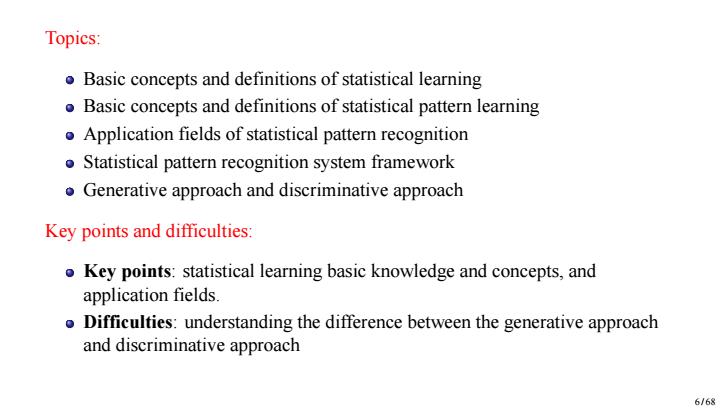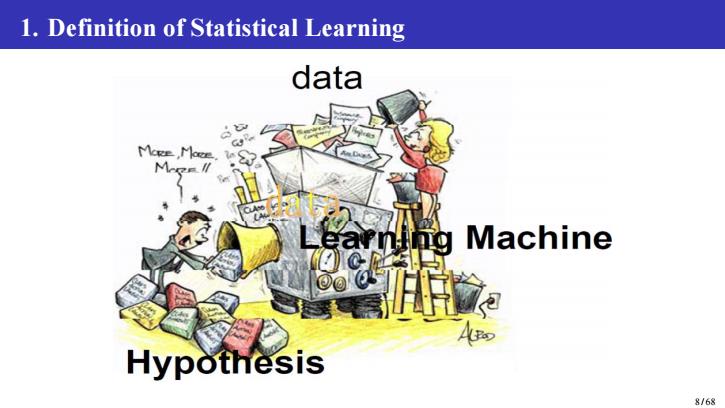
Statistical Learning Theory and Applications Lecture 1 Introduction Instructor:Quan Wen SCSE@UESTC Fall 2021
Statistical Learning Theory and Applications Lecture 1 Introduction Instructor: Quan Wen SCSE@UESTC Fall 2021

Textbook 1 S.Theodoridis and K.Koutroumbas,Pattern Recognition,4th edition, Academic Press.2009 2 C.M.Bishop,Pattern Recognition and Machine Learning,Springer,2006 References I.Goodfellow,Y.Bengio,A.Courville,Deep Learning,MIT Press,2016 2 R.O.Duda,P.E.Hart,and D.G.Stork,Pattern Classification,2nd edition, John Wiley Sons,Inc.,2001 1/68
Textbook 1 S. Theodoridis and K. Koutroumbas, Pattern Recognition, 4th edition, Academic Press, 2009 2 C. M. Bishop, Pattern Recognition and Machine Learning, Springer, 2006 References 1 I. Goodfellow, Y. Bengio, A. Courville, Deep Learning, MIT Press, 2016 2 R.O. Duda, P.E. Hart, and D.G. Stork, Pattern Classification, 2nd edition, John Wiley & Sons, Inc., 2001 1 / 68

Syllabus Lecture 1:Introduction(1 session) Lecture 2:Review of Linear Algebra and Probability Theory(2 sessions) Lecture 3:Regression Models(4 sessions) Lecture 4:Perceptron(4 sessions) Lecture 5:Support Vector Machines(10 sessions) o Lecture 6:Multilayer Perceptrons(6 sessions) Lecture 7:Ensemble Methods(4 sessions) Lecture 8:Data Representation-Parametric Models(4 sessions) Lecture 9:Data Representation-Non-Parametric Models(3 sessions) o Lecture 10:Unsupervised Learning(2 sessions) 2/68
Syllabus Lecture 1: Introduction(1 session) Lecture 2: Review of Linear Algebra and Probability Theory (2 sessions) Lecture 3: Regression Models (4 sessions) Lecture 4: Perceptron (4 sessions) Lecture 5: Support Vector Machines (10 sessions) Lecture 6: Multilayer Perceptrons (6 sessions) Lecture 7: Ensemble Methods (4 sessions) Lecture 8: Data Representation - Parametric Models (4 sessions) Lecture 9: Data Representation - Non-Parametric Models (3 sessions) Lecture 10: Unsupervised Learning (2 sessions) 2 / 68

Mathematical Notation o Matrix Notations x:scalar x:vector,for x=(x1,...,xM) xT:vector x's transpose X:matrix,with its element at ith row and jth column asXi XT:matrix X's transpose Iy:Mx Midentity matrix Probability and Statistics Notations X,Y:random variables Y and Y x,y:realized values (lowercase)of the random variables Xand Y(uppercase) sample space(uppercase script Roman letters) 0,A:parameters(lowercase Greek letter) e,:parameter space(uppercase script Greek letters) 4/68
Mathematical Notation Matrix Notations xi : scalar x: vector, for x = (x1, . . . , xM) x T : vector x’s transpose X: matrix,with its element at ith row and jth column as Xij X T : matrix X’s transpose IM: M × M identity matrix Probability and Statistics Notations X, Y: random variables X and Y x, y: realized values (lowercase) of the random variables X and Y (uppercase) X , Y: sample space (uppercase script Roman letters) θ, λ: parameters (lowercase Greek letter) Θ, Ω: parameter space (uppercase script Greek letters) 4 / 68

Outline (Level 1) Definition of Statistical Learning 2 Application Case of Statistical Pattern Recognition 3 SPR System Framework and Design Cycle 4 Basic Concepts 5 Machine Learning in Different AI Disciplines 5/68
Outline (Level 1) 1 Definition of Statistical Learning 2 Application Case of Statistical Pattern Recognition 3 SPR System Framework and Design Cycle 4 Basic Concepts 5 Machine Learning in Different AI Disciplines 5 / 68

Topics: Basic concepts and definitions of statistical learning Basic concepts and definitions of statistical pattern learning Application fields of statistical pattern recognition Statistical pattern recognition system framework Generative approach and discriminative approach Key points and difficulties: o Key points:statistical learning basic knowledge and concepts,and application fields. oDifficulties:understanding the difference between the generative approach and discriminative approach 6/68
Topics: Basic concepts and definitions of statistical learning Basic concepts and definitions of statistical pattern learning Application fields of statistical pattern recognition Statistical pattern recognition system framework Generative approach and discriminative approach Key points and difficulties: Key points: statistical learning basic knowledge and concepts, and application fields. Difficulties: understanding the difference between the generative approach and discriminative approach 6 / 68

Outline (Level 1) Definition of Statistical Learning Application Case of Statistical Pattern Recognition SPR System Framework and Design Cycle Basic Concepts Machine Learning in Different Al Disciplines 7/68
Outline (Level 1) 1 Definition of Statistical Learning 2 Application Case of Statistical Pattern Recognition 3 SPR System Framework and Design Cycle 4 Basic Concepts 5 Machine Learning in Different AI Disciplines 7 / 68

1.Definition of Statistical Learning data Machine Hypothesis 8/68
1. Definition of Statistical Learning 8 / 68

Outline (Level 1-2) Definition of Statistical Learning o Definition of"Statistics" o Definition of"Learning Definition of Statistical Learning o Definition of Pattern 9/68
Outline (Level 1-2) 1 Definition of Statistical Learning Definition of “Statistics” Definition of “Learning” Definition of Statistical Learning Definition of Pattern 9 / 68

l.l.Definition of“Statistics'” 1"The study of the collection,organization,analysis,interpretation and presentation of data",Oxford Dictionary of Statistical Terms. 2 Descriptive Statistics:Summarize and describe the collected data,such as mean and variance.what happened 3 Predictive Statistics:Modeling the collected data and make inferences about the population,such regression analysis.what will happen 4 Prescriptive Statistics:Modeling the collected data and make decisions for the next step.what to do Any function of the samples is a statistic,such as the sample mean and variance 10/68
1.1. Definition of “Statistics” 1 ”The study of the collection, organization, analysis, interpretation and presentation of data”, Oxford Dictionary of Statistical Terms. 2 Descriptive Statistics: Summarize and describe the collected data, such as mean and variance. what happened 3 Predictive Statistics: Modeling the collected data and make inferences about the population, such regression analysis. what will happen 4 Prescriptive Statistics: Modeling the collected data and make decisions for the next step. what to do Any function of the samples is a statistic, such as the sample mean and variance 10 / 68